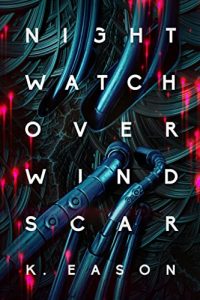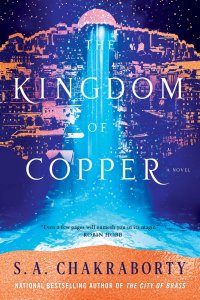Alexandra Pierce Reviews Nightwatch Over Windscar by K. Eason
 Nightwatch Over Windscar, K. Eason (DAW 978-0-75641-859-5, $28.00, 480pp, hc) November 2022. Cover by Tim Green.
Nightwatch Over Windscar, K. Eason (DAW 978-0-75641-859-5, $28.00, 480pp, hc) November 2022. Cover by Tim Green.
First things first: you definitely don’t want to read this without reading the first in the series, Nightwatch on the Hinterlands (2021). This second book in the series opens just months after the events in the first, and while there is a little backstory as a reminder of the stakes, it’s definitely not enough to make this stand alone. You can, however, read it without reading Eason’s first in this universe.
Secondly: this is not a book to take too seriously. It’s not aiming to be a serious treatise on the problems of warfare or interspecies relations. Instead, this feels like an old-school military SF with a Star Trek-like cast of aliens. Or, as I discovered when I read the acknowledgements, Dungeons & Dragons: there, Eason recognizes that the Nightwatch books owe a huge debt to a game she played pre-COVID. I will admit that it took me an embarrassingly long time to realize that the description of Iari, with her tusks, was rather like that of the classic orc; while Gaer, with his spines and half-raptor, half-reptile biology, was rather like a dragon. These two are the main characters – the warrior and the diplomat-magician-spy – and they are joined by robots, a fixer, a doctor-magician, and occasionally others when needed (including a single human). Which, yes, does sound a lot like a D&D party, now that you mention it.
In the first book, Iari-the-soldier is babysitting Gaer-the-diplomat, when they end up having to battle an incursion of the Brood – creatures from another dimension inimical to life in theirs – which have apparently been deliberately summoned. Given this universe only barely fought off a galaxy-spanning incursion by the Brood a few years before, this is rather egregious. In this sequel, Iari and Gaer and friends are investigating who was involved in these actions. They discover backwoods-types being taken advantage of, xenophobia being stoked, people messing with magic they really don’t understand, and quite a few occasions where fighting is the only option.
There’s a lot of fighting in this book. Fast-paced, generally well-described, and never lasting too long, it’s a core element of the story. Which isn’t to say that there’s only fighting; far from it. Eason does some pretty decent characterization: in particular, the main soldiers are quite nuanced. Iari was regular infantry and then joined the Aedis, a Knights-Templar-ish organization (which I guess makes her a paladin); she has had dreadful battle experiences, which still mark her literally and psychically. When she was infantry, she fought with Corso (the fixer) – but he then went his own way, into civilian life. The events of the first book brought them back together, and seeing Iari accept that Corso isn’t automatically a coward for his choices is a thoughtful part of the overall story.
The central relationship is Iari and Gaer – representatives of races who until a few decades ago were at war, brought together to fight the Brood and now in an occasionally uneasy alliance. The relationship between Iari and Gaer reflects this complexity, especially as they try to solve their present problem. Gaer’s situation is fraught – officially a diplomat, also a spy, he must figure out how to balance conflicting loyalties and not give any side an excuse to either sideline or kill him. He’s somewhat less convincing as a character than Iari, despite both of them having point-of-view chapters.
It would be remiss of me not to mention the sort-of-magical aspects. Gaer is an arithmancer: he casts hexes, and he can see and work in various layers of aether to manipulate reality. The vocabulary used suggests a messing-with-the-base-code-of-the-universe idea – there’s talk of equations, and arithmancy being ‘‘the mother tongue of the multiverse.’’ There are also people who use alchemy, along with various bastardizations of the two (the latter really annoys Gaer, who is a purist in these things). Ultimately, though, Eason doesn’t need you to try and understand what’s going on, and honestly I suspect it’s better if you don’t think too hard about it. Like warp drives and the Force, trying to understand it is beside the point. Accept that these things work in this universe, and can be used for good and ill, and proceed.
Magic and technology, a multi-species alliance, a threat from another dimension (and from within theirs as well), superiors who just don’t understand what’s going on: I’m not going to claim that this is brilliantly original, but it sure is a lot of fun.
Alexandra Pierce reads, writes, podcasts, cooks and knits; she’s Australian and a feminist. She was a host of the Hugo Award winning podcast Galactic Suburbia for a decade; her new podcast is all about indie bookshops and is called Paper Defiance. Alex has edited two award-winning non-fiction anthologies, Letters to Tiptree and Luminscent Threads: Connections to Octavia E Butler. She reviews a wide range of books at www.randomalex.net.
This review and more like it in the February 2023 issue of Locus.
 While you are here, please take a moment to support Locus with a one-time or recurring donation. We rely on reader donations to keep the magazine and site going, and would like to keep the site paywall free, but WE NEED YOUR FINANCIAL SUPPORT to continue quality coverage of the science fiction and fantasy field.
While you are here, please take a moment to support Locus with a one-time or recurring donation. We rely on reader donations to keep the magazine and site going, and would like to keep the site paywall free, but WE NEED YOUR FINANCIAL SUPPORT to continue quality coverage of the science fiction and fantasy field.
©Locus Magazine. Copyrighted material may not be republished without permission of LSFF.







